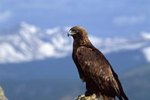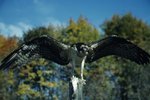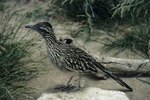
Located along the east coast's Chesapeake Bay, the state of Maryland is home to 13 birds of prey, including eight hawk species. Fort Smallwood Park, in northern Anne Arundel County is popular among hawk-watching birders and may be the optimal location for observing the spring raptor migration. Maryland's hawks belong to three genera -- Accipiter, Buteo and Circus.
Characteristics
Hawks are medium-sized carnivorous predators known as raptors. They have excellent vision, and can see eight times farther than humans can. Hawks grab and hold prey during flight with their long, sharp talons, and use their strong hooked beaks to tear flesh. They inhabit shrubby wooded areas where prey is abundant. Most hawks mate for life.
Genus Accipiter
The genus Accipiter includes goshawks and sparrowhawks. Cooper's hawk (Accipiter cooperii), the sharp-shinned hawk (Accipiter striatus) and the northern goshawk (Accipiter gentilis) are found in Maryland. These birds are slender-bodied with short, round-tipped, broad wings and long tails. Birds and small mammals are their preferred prey.
Genus Buteo
Buzzards and some hawks are included in the genus Buteo. The broad-winged hawk (Buteo platypterus), red-shouldered hawk (Buteo lineatus), red-tailed hawk (Buteo jamaicensis), rough-legged hawk (Buteo lagopus) and Swainson's hawk (Buteo swainsoni) live in Maryland. They're sturdily built and heavy-bodied with broad, rounded wings and a short tail. They hunt small mammals and rodents.
Genus Circus
Harriers belong to the genus Circus. The name Circus was taken from circling movements made by male and female harriers during courtship. Northern harriers, found in Maryland, are slim-bodied and long-winged with owl-like faces. Their long tails have a white patch at the base. Harriers hunt by flying low over marshes and meadows, searching for small mammals, birds and reptiles. These unusual hawks nest in marshes and don't mate for life.
References
Resources
Photo Credits
-
Tom Brakefield/Stockbyte/Getty Images
Writer Bio
Karen Mihaylo has been a writer since 2009. She has been a professional dog groomer since 1982 and is certified in canine massage therapy. Mihaylo holds an associate degree in human services from Delaware Technical and Community College.




